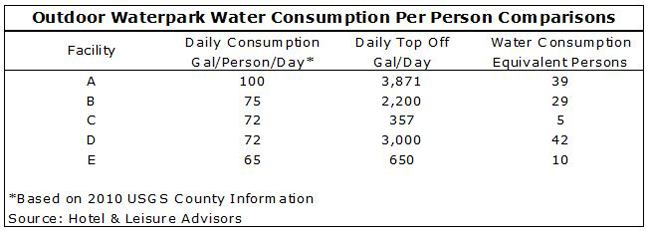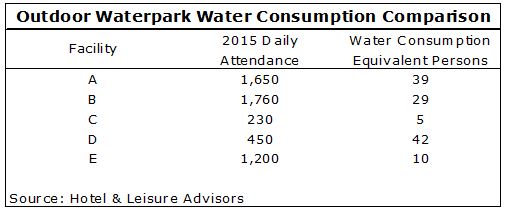
by Eric B. Hansen, AIA, ISHC
A water consumption ratio is a metric by which we can begin to understand the actual consumption of water at recreational water attractions. As identified in part one of this series, the water consumption ratio is the number of gallons used daily as top off for a water attraction divided by the total initial fill gallons. The ratio represents the portion of the water actually consumed on a daily or monthly basis. This article profiles several outdoor waterpark attractions and analyzes their water consumption versus their water use.
For purposes of our discussion, the initial fill gallons equate to the amount of water used or the attraction’s water use. The amount of water added to the system equates to water consumption.
Outdoor Waterpark Profiles
The following are profiles of outdoor waterparks in various regions across the United States. We have kept their identities confidential and appreciate their willingness to share their water consumption statistics to benefit the industry.
Outdoor Waterpark A is in the Southeast and includes approximately 63,000 square feet of aquatic surface area, zero entry wave pool, lazy river, tipping bucket play structure, mat racer, slide tower with three slides, and splash pad. The venue is open approximately 100 days per season with an average attendance of 1,650 per day.
Outdoor Waterpark B is in the Northeast and includes approximately 30,000 square feet of wet area with no standing bodies of water, only run-out troughs and splash pads. The venue offers two slide towers with a total of five slides, play structure with tipping bucket, and splash pad. The venue is open 100 days per season with an average attendance of 1,760 per day.
Outdoor Waterpark C is in the Midwest and includes a 10,100 square foot lap pool with slide tower and two slides, a 1,600 square foot diving well, and a kiddie splash pool of 1,600 square feet with mushroom geysers. The facility is open approximately 100 days per year with an average attendance of 230 per day.
Outdoor Waterpark D is in the Midwest and includes an aquatic surface area of 13,200 square feet with a zero entry pool, lazy river, lap pool with diving well, slide tower with three slides, and a tipping bucket play structure. The facility is open approximately 100 days per year and has an average attendance of 450 per day.
Outdoor Waterpark E is in the central region of the country and includes a wave pool, lazy river, two kiddie pools, five slide towers with more than 12 slides, and extreme water attractions. The facility is open approximately 100 days per year with an average attendance of 1,200 per day.
For outdoor waterparks, climate affects evaporation and water consumption. More water evaporates in arid climates. Wind speed and temperatures also affect evaporation. The following table presents the profiled waterparks and their water consumption ratios.
The consumption ratio is as varied as the waterpark locations, which illustrates the complexities involved in assessing water consumption at outdoor waterparks. More data is needed in order to benchmark consumption ratios and develop more complete analysis. However, the data shown in this article provide generalities regarding waterpark design. For instance, a larger body of water for an initial fill (water use) does not necessarily mean a higher water consumption ratio. Other variables for consideration are the types and ages of filtration systems used. Facility A utilizes high-speed sand filters; Facility B utilizes a combination of sand filters and regenerative media filters; Facility C utilizes DE (Diatomaceous Earth) filters; Facilities D and E utilize high-speed sand filters. Many of the properties we interviewed report anticipated capital replacements of filtration systems to help reduce water consumption.
Another variable that affects water consumption are the water attractions. Facility B does not offer any large body or pool of water, and its water use comes from the system’s splash-out and spray attractions; therefore, its water consumption ratio is higher than the other facilities. But this does not necessarily mean Facility B’s 4.89% consumption ratio is out of balance comparatively. Rather, what is needed is a means to understand the water consumption ratio with regard to the overall amount of water consumed for that particular location on a per capita basis.
Water Consumption Per Capita Comparisons
The U.S. Geological Survey collects water use data by state and county in a variety of categories of use. For our analysis we reviewed domestic use – water used for indoor and outdoor household purposes. These figures represent how much water an individual consumes on a daily basis. The following table presents the profiled waterparks’ domestic per capita water consumption per day based on 2010 county information. We note that these figures are for water that is public-supplied and not self-supplied.
The daily top-off water consumption (gallons per day) at each facility is divided by the location’s daily domestic water consumption (gallons per person per day). The resulting figure equates to an equivalent number of people in water consumption that the waterpark achieves. Facility B, for example, consumes as much water as 29 individuals living in that community on a daily basis, while Facility D consumes as much water as 42 individuals living in that community on a daily basis. These daily figures can now be compared to daily attendance figures.
The water consumption-equivalent persons represent a fraction of the total attendance at each waterpark. Water use benefits 100% of attendees. For example, Facility A’s water use benefits all 1,650 attendees, while its water consumption is the equivalent of what 39 people consume on a daily basis. The analysis supports the notion that water consumption at waterparks is relatively low.
In a time where water conservation has taken center stage in drought and drought-prone areas, the waterpark industry needs to clearly articulate its position and respond to inaccurate perceptions of water waste and consumption at recreational water attractions.
Waterpark Water Conservation Key Points
The following is a summary of key points and definitions regarding water use and water conservation at waterparks. These points can be a part of the industry’s ongoing dialogue regarding water conservation.
• Water Use = initial fill, i.e. the amount of water in the entire water system used by all in attendance
• Water Consumption = daily or monthly top off, i.e. the amount of water consumed at the attraction
• Water Consumption Ratio = water consumption divided by water use
• Water Consumption and Water Use are not interchangeable terms
• Water Consumption results from four waterpark operations
- Backwash
- Evaporation
- Deck Wash Down
- Splash Out
• Water Consumption is affected by many variables, including seasonality, physical water attraction attributes, and climate.
• Indoor Waterparks and Outdoor Waterparks have different water consumption ratios, most attributable to climate and evaporation variables.
• Big recreation water attractions allow water use for a population that is an alternative to residential swimming pools in drought-stricken areas.
• Water conservation at waterparks is an inherent design principle as owners/operators continually seek improvements to lower water consumption ratios that are driven by operating costs. Saving water one drop at a time adds to the bottom line.
Originally published by World Waterpark Magazine




